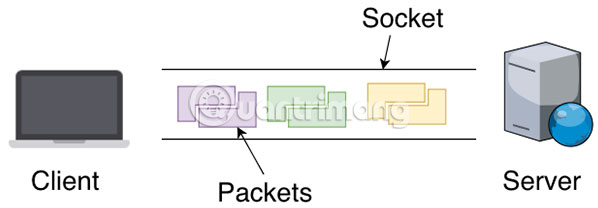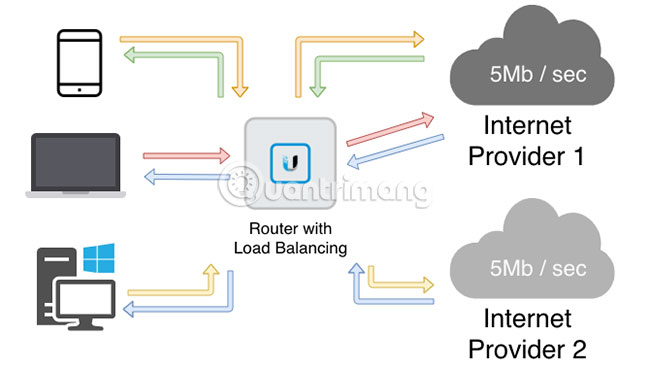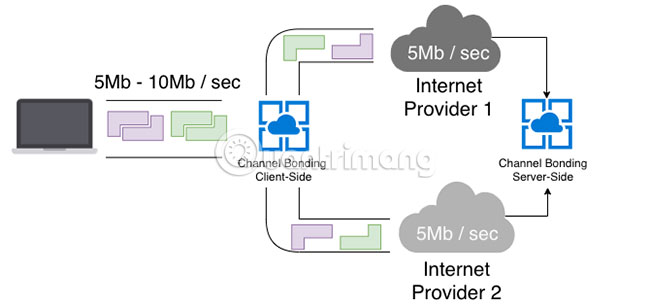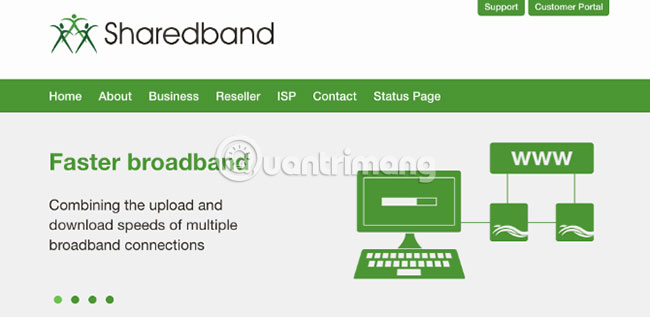What is channel bonding?
A slow Internet connection is really frustrating. But if you're limited by your service provider's speed, what are your options for a better browsing experience? Channel bonding may be the answer to this problem.
Learn about channel bonding and how it speeds up Internet connection
- Use multiple Internet connections
- Learn how Internet data is routed
- What is load balancing?
- What is channel bonding?
- Channel bonding software
- What to do if you can use channel bonding?
Use multiple Internet connections
Internet speed is usually limited by region. Your service provider will need to deploy the necessary infrastructure to your place of residence or workplace. If you require more bandwidth than what your ISP provides on one connection, you'll need an additional Internet connection, be it from the same provider with the same technology or another provider that comes with the technology. other.
Many companies offer this option and it has its own use. In case of a provider's connection failure, there will be a backup connection to which all Internet traffic is directed. This process is called 'failover'.
However, failover will not help speed up the Internet. To do that, you need load balancing or channel bonding.
Both load balancing and channel bonding have different use cases, costs, and warnings. Finally, it addresses the way Internet traffic is routed on the network.
Learn how Internet data is routed
Let's look at an overview of Internet requirements. To load the webpage you are currently reading, the computer and browser will connect to a server, providing the necessary files. Imagine connecting to the Internet like a set of pipes.

The various components of this website such as text and images are distributed (in the form of data packets) through a socket. Think of a socket as a pipeline for information extending from the server to your location. If the socket is a pipe, then the packets are liquid flowing through it.
For example, the image you see above is first divided into individual packets and sent over a socket. It was then reassembled by the web browser.
What is load balancing?
Load balancing is the approach where Internet traffic is divided between two or more Internet providers. To perform load balancing, you will need a router capable of connecting multiple WANs.

Each Internet connection can be from a provider or even other technology. For example, you can connect the router to an optical cable network and LTE network. In addition to the cost factor, one client device is still limited to only one network connection at a time.
In the diagram above, the network has access to two 5Mbps Internet connections. If a user wants to stream a movie that requires 8 Mbps, the load balancing will not help. This is because streaming movies requires a large single socket to stream movies from the server to you.
What is channel bonding?
Channel bonding divides web traffic at the packet level between multiple Internet connections. This means channel bonding will be effective even for users who are trying to stream a big movie because the traffic is divided low.
While load balancing divides network traffic, channel bonding effectively combines many different Internet connections into one.

To make this happen, Internet traffic needs to be divided and combined. There are both hardware and software options for channel linking. Hardware options will be required if you want your entire network to take advantage of channel bonding.

A company like Shareband will give you a device that can plug in many Internet connections. Your data is sent securely to this company over multiple Internet connections, then processed and sent back to you.
Hardware options will still require registration because the company is using their server to divide and combine Internet traffic.
One of the use cases here is that connecting an optical cable to your home can cost a considerable amount of money. To solve this problem, you can use two cheaper ADSL connections to your home and link them together.
Subscription costs for channel bonding plus two ADSL connections may still be lower than an individual fiber optic cable, but it depends on the case.
Channel bonding software
Fortunately, you may already own a device that can use multiple Internet connections simultaneously, in the form of a smartphone.
Using the software, you can link your WiFi and LTE connection.
Such an application is called Speedify. Speedify.com is essentially a VPN but as its name suggests it can help speed up the Internet experience by using channel bonding. Speedify is available for Windows, macOS, iOS and Android applications.
- Download Speedify for iOS
- Download Speedify for Android
Speedify allows you to use all WiFi, 3G, 4G and wired connections at the same time to accelerate the Internet experience.


To get an idea of an effective solution, you can run 3 speed tests. One experiment uses only WiFi, one uses LTE and the other uses Speedify's channel bonding feature, combining both WiFi and LTE.


The speed test results above show a great improvement when the connections are combined. From this simple test, you can see how channel bonding benefits for a faster browsing experience. Speedify also offers a free option, optimizing the first 5GB for free each month.
Having the Speedify app on your smart device won't help any other device on the network. Luckily, the production company Speedify also published an app called Connectify. Connectify turns a Windows computer into a virtual router that can share its Internet connection.
With a little configuration, you can use a Windows computer to connect to Ethernet and a 4G Internet connection (using a dongle).
You can then use Connectify to share that connection with the rest of the network. Keep in mind that mobile data can be very expensive, so be sure to use the limited feature on Speedify to make sure you don't get a hefty bill by the end of the month.
What to do if you can use channel bonding?
If channel bonding or a faster Internet connection is not an option available to you, there are other options. Ubiquiti's UniFi allows you to set download and upload limits for both groups and users. This can help shape the Internet connection and provide a better browsing experience for the network.
Other systems like AmpliFi have a feature called Quality of Service or QoS. Be sure to check the router settings to see if it supports QoS, if your network is severely congested. Channel bonding comes with a decent cost to combine both channels. However, channel bonding can give you and your network a much needed improvement in Internet speed when other methods do not work.
If you want the Internet to be faster but can afford channel bonding, try adjusting your DNS settings for faster Internet speeds.
You should read it
- Set up 802.11n Channel Bonding to achieve 300Mbps speed
- How to choose the best WiFi channel for the router
- Here's how to change your YouTube channel name and URL
- Instructions for searching and following WhatsApp channels
- 7 things to note when starting YouTube channel
- How to create a channel channel on Youtube
- How to switch between Dev Channel and Beta Channel on Windows 11
- Instructions on how to create or edit your Youtube channel image
- Group YouTube channel managers
- Why need to change the wireless channel of the router?
- How to create a new channel on YouTube?
- How to export a registered YouTube channel






 Set up 802.11n Channel Bonding to achieve 300Mbps speed
Set up 802.11n Channel Bonding to achieve 300Mbps speed How to choose the best WiFi channel for the router
How to choose the best WiFi channel for the router Here's how to change your YouTube channel name and URL
Here's how to change your YouTube channel name and URL Instructions for searching and following WhatsApp channels
Instructions for searching and following WhatsApp channels 7 things to note when starting YouTube channel
7 things to note when starting YouTube channel How to create a channel channel on Youtube
How to create a channel channel on Youtube